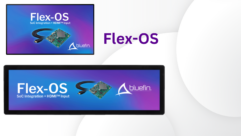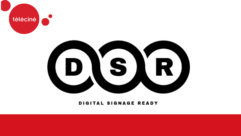

Digital Signage Expo: A Monumental Event
I just returned from Digital Signage Expo in Vegas, the show to attend if you have anything to do with the exploding digital signage industry.
I just returned from Digital Signage Expo in Vegas, the show to attend if you have anything to do with the exploding digital signage industry. I was teaching, exhibiting, and learning—enjoying the show from every angle. On one level, it was “another event,” but an event that was exciting for the division I work in, and an important way to gather all the information we could about the players in our industry.
Every DSE show has gotten bigger and better, having refined itself over the past four years from a “digital retailing” event to a pure digital signage and interactive technology one-stop shop. The event has also grown into an east-west format, with the first fall event taking place in Philadelphia this coming September.
As I entered the show floor during setup on Monday, I did the usual scan of vendors and got a quick lay of the land. All the players that should have been there were there.
What I didn’t know at the time was that the show would conclude with a meeting that had the potential to make digital signage history. At the very at least, all involved would someday say, “I was there.” But first the show.
The landscape had the usual big players. At InfoComm, you expect Extron, AMX, Crestron, and all the display manufacturers, just to name a few, to have big booths. DSE was no different, with key signage players Planar, Scala, Symon, Helius, BroadSign, and Wireless Ronin taking up major real estate on the show floor.
And like other shows, booth size didn’t dictate importance—there were plenty of 10 x 20s that housed killer products and services. I like to spend a lot of my time at these booths, meeting with innovators who have some of the most interesting and cutting-edge technologies and services. Overall DSE showcased signage solution vendors and more—computers, infrastructure, displays, content, integration. In all, more than 160 vendors showed their wares, all focused on digital signage components and interactive technologies.
So what did guys like you and me think of what they were showing?
THE BIG QUESTION
The most common question I heard from attendees investigating the new technology medium and what it could do for them (many of them end-users) was, “How does it all fit together into a solution?”
That’s not a surprising question—integrators love to hear people ask it. And for many of us already doing digital signage installations, the pieces make sense.
But many of the attendees I talked to found signage to be overwhelming. The software choices seemed endless; the display selections confusing (what’s the difference between all of them?); and the rest of the necessary components of a solution barely understood.
Such confusion underscores the need for a partner—the integrator—in any signage venture. It’s a need that will only increase over time. When I speak to analysts, the projected industry growth numbers are staggering. And some even argue the numbers bandied about are gross underestimates, based on flawed sampling.
Nevertheless, it was easy to feel the electricity in the air. The single most important feeling I walked away from the show with—this is going to be big.
THE MEETING THAT STARTED IT ALL
As the show winded down and I’d seen as much as I could absorb, I was invited to a meeting taking place in one of the breakout session rooms. I was expecting it to be merely an interesting gathering, but it turned into a critical one.
The meeting was convened by Lou Giacalone of Titan Worldwide, a pioneer in the digital signage industry and now at the helm of Titan’s digital initiative. Titan itself is one of the leading outdoor media companies.
Giacalone’s message was simple in concept, but monumental in scope—we need digital signage industry standards.
The room was littered with industry power-houses, with most of the major players represented by top-level delegates. At first I felt like I was back in high school, when one senior would call out another and we were there to watch the fight, not knowing who would win but knowing it would be good. I had a hunch, though.
Giacalone represented a huge player and potentially lucrative customer getting up in front of these guys and saying, essentially, “You all need to work together so we can pick the best pieces from each of you and build a solution that meets our exact needs, not the needs you think we have.” It’s an important concept—not necessarily new thinking, but new to the digital signage industry.
The basis of Titan’s initiative was to create a standard method of communication between the three core components of any enterprise digital signage solution: servers, middleware, and players. He wanted a mechanism for back-end business systems—with all of their business logic—to communicate with a digital signage middleware server, and another mechanism so the server could communicate with the digital signage players at the edge of the network—and he wanted them based on standard protocols.
PLAYING NICELY
So there was Lou, standing in front of these various solution providers, telling them that Titan and other out-of-home advertising companies would be spending massive amounts of money going forward, but that the industry had to start playing nicely together or risk losing business.
Multivendor development was the only way, he said, that digital signage could grow. Such development would lead to something Titan and other customers dearly want—and which should be music to integrators’ ears—the end of single-vendor solutions. The fewer proprietary systems there are, the more integration that needs to happen.
In a breakout room in Las Vegas, an industry heavyweight gave his vision for digital signage, including a straightforward, to-the-point, nine-slide PowerPoint presentation. It made a ton of sense—especially from the perspective of the buyer—but how did the room react? Surprisingly positively. I was waiting for these high school seniors to start throwing punches and all I got was a friendly group of guys hanging out after school.
The vendors were open to cross-platform communication protocols. The discussion concluded with the commitment from all to develop a standards body initiative, with some ideas on a parent organization to house the body.
I’m still not sure if it was Giacalone and the pot of cash he was waiting to pour into digital signage, or if it was the vendors seizing an opportunity to better the industry. All I know is that this little meeting at Digital Signage Expo potentially launched something this entire growing industry needs—standardization.
Kris Vollrath is vice president of Advanced AV in West Chester, Pa., and an industry consultant. He can be reached at [email protected].










